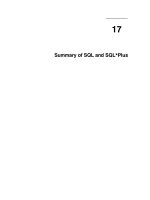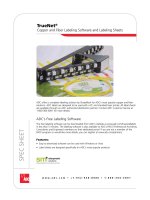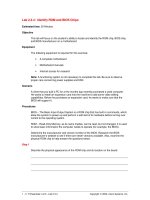COMPUTATIONAL METHODS HI SURFACE AND COLLOID SCIENCE docx
Bạn đang xem bản rút gọn của tài liệu. Xem và tải ngay bản đầy đủ của tài liệu tại đây (13.72 MB, 942 trang )
COMPUTATIONAL
METHODS
HI
SURFACE
AND
COLLOID SCIENCE
SURFACTANT SCIENCE SERIES
FOUNDING EDITOR
MARTIN J. SCHICK
1918-1998
SERIES EDITOR
ARTHUR T. HUBBARD
Santa Barbara Science Project
Santa Barbara, California
ADVISORY BOARD
DANIEL BLANKSCHTEIN
Department of Chemical Engineering
Massachusetts Institute of Technology
Cambridge, Massachusetts
S. KARABORNI
Shell International Petroleum
Company Limited
London, England
LISA B. QUENCER
The Dow Chemical Company
Midland, Michigan
JOHN F. SCAMEHORN
Institute for Applied Surfactant
Research
University of Oklahoma
Norman, Oklahoma
P.
SOMASUNDARAN
Henry Krumb School of Mines
Columbia University
New York, New York
ERIC W. KALER
Department of Chemical Engineering
University of Delaware
Newark, Delaware
CLARENCE MILLER
Department of Chemical Engineering
Rice University
Houston, Texas
DON RUBINGH
The Proctor & Gamble Company
Cincinnati, Ohio
BEREND SMIT
Shell International Oil Products B. V.
Amsterdam, The Netherlands
JOHN TEXTER
Strider Research Corporation
Rochester, New York
1.
Nonionic Surfactants, edited by Martin J. Schick (see also Volumes 19, 23,
and 60)
2.
Solvent Properties of Surfactant Solutions, edited by Kozo Shinoda (see
Volume 55)
3. Surfactant Biodegradation, R. D. Swisher (see Volume 18)
4.
Cationic Surfactants, edited by Eric Jungermann (see also Volumes 34, 37,
and 53)
5. Detergency: Theory and Test Methods (in three parts), edited by W. G.
Cutler and R. C. Davis (see also Volume 20)
6. Emulsions and Emulsion Technology (in three parts), edited by Kenneth J.
Lissant
7. Anionic Surfactants (in two parts), edited by Warner M. Linfield (see Volume
56)
8. Anionic Surfactants: Chemical Analysis, edited by John Cross
9. Stabilization of Colloidal Dispersions by Polymer Adsorption, Tatsuo Sato
and Richard Ruch
10.
Anionic Surfactants: Biochemistry, Toxicology, Dermatology, edited by
Christian Gloxhuber (see Volume 43)
11.
Anionic Surfactants: Physical Chemistry of Surfactant Action, edited by E. H.
Lucassen-Reynders
12.
Amphoteric Surfactants, edited by B. R. Bluestein and Clifford L. Hilton (see
Volume 59)
13.
Demulsification: Industrial Applications, Kenneth J. Lissant
14.
Surfactants in Textile Processing, Arved Datyner
15.
Electrical Phenomena at Interfaces: Fundamentals, Measurements, and Ap-
plications, edited by Ayao Kitahara and Akira Watanabe
16.
Surfactants in Cosmetics, edited by Martin M. Rieger (see Volume 68)
17.
Interfacial Phenomena: Equilibrium and Dynamic Effects, Clarence A. Miller
and P. Neogi
18.
Surfactant Biodegradation: Second Edition, Revised and Expanded, R. D.
Swisher
19.
Nonionic Surfactants: Chemical Analysis, edited by John Cross
20.
Detergency: Theory and Technology, edited by W. Gale Cutler and Erik
Kissa
21.
Interfacial Phenomena in Apolar Media, edited by Hans-Friedrich Eicke and
Geoffrey D. Parfitt
22.
Surfactant Solutions: New Methods of Investigation, edited by Raoul Zana
23.
Nonionic Surfactants: Physical Chemistry, edited by Martin J. Schick
24.
Microemulsion Systems, edited by Henri L. Rosano and Marc Clausse
25.
Biosurfactants and Biotechnology, edited by Nairn Kosaric, W. L Cairns, and
Neil C. C. Gray
26.
Surfactants in Emerging Technologies, edited by Milton J. Rosen
27.
Reagents in Mineral Technology, edited by P. Somasundaran and Brij M.
Moudgil
28.
Surfactants in Chemical/Process Engineering, edited by Darsh T. Wasan,
Martin E. Ginn, and Dinesh O. Shah
29.
Thin Liquid Films, edited by I. B. Ivanov
30.
Microemulsions and Related Systems: Formulation, Solvency, and Physical
Properties, edited by Maurice Bourrel and Robert S. Schechter
31.
Crystallization and Polymorphism of Fats and Fatty Acids, edited by Nissim
Garti and Kiyotaka Sato
32.
Interfacial Phenomena in Coal Technology, edited by Gregory D. Botsaris
and Yuli M. Glazman
33.
Surfactant-Based Separation Processes, edited by John F. Scamehorn and
Jeffrey H. Harwell
34.
Cationic Surfactants: Organic Chemistry, edited by James M. Richmond
35.
Alkylene Oxides and Their Polymers, F. E. Bailey, Jr., and Joseph V.
Koleske
36.
Interfacial Phenomena in Petroleum Recovery, edited by Norman R. Morrow
37.
Cationic Surfactants: Physical Chemistry, edited by Donn N. Rubingh and
Paul M. Holland
38.
Kinetics and Catalysis in Microheterogeneous Systems, edited by M. Gratzel
and K. Kalyanasundaram
39.
Interfacial Phenomena in Biological Systems, edited by Max Bender
40.
Analysis of Surfactants, Thomas M. Schmitt
41.
Light Scattering by Liquid Surfaces and Complementary Techniques, edited
by Dominique Langevin
42.
Polymeric Surfactants, Irja Piirma
43.
Anionic Surfactants: Biochemistry, Toxicology, Dermatology. Second Edition,
Revised and Expanded, edited by Christian Gloxhuberand Klaus Kunstler
44.
Organized Solutions: Surfactants in Science and Technology, edited by Stig
E. Friberg and Bjorn Lindman
45.
Defoaming: Theory and Industrial Applications, edited by P. R. Garrett
46.
Mixed Surfactant Systems, edited by Keizo Ogino and Masahiko Abe
47.
Coagulation and Flocculation: Theory and Applications, edited by Bohuslav
Dobias
48.
Biosurfactants: Production • Properties • Applications, edited by Nairn Ko-
saric
49.
Wettability, edited by John C. Berg
50.
Fluorinated Surfactants: Synthesis • Properties • Applications, Erik Kissa
51.
Surface and Colloid Chemistry in Advanced Ceramics Processing, edited by
Robert J. Pugh and Lennart Bergstrom
52.
Technological Applications of Dispersions, edited by Robert B. McKay
53.
Cationic Surfactants: Analytical and Biological Evaluation, edited by John
Cross and Edward J. Singer
54.
Surfactants in Agrochemicals, Tharwat F. Tadros
55.
Solubilization in Surfactant Aggregates, edited by Sherril D. Christian and
John F. Scamehorn
56.
Anionic Surfactants: Organic Chemistry, edited by Helmut W. Stache
57.
Foams: Theory, Measurements, and Applications, edited by Robert K. Prud'-
homme and SaadA. Khan
58.
The Preparation of Dispersions in Liquids, H. N. Stein
59.
Amphoteric Surfactants: Second Edition, edited by Eric G. Lomax
60.
Nonionic Surfactants: Polyoxyalkylene Block Copolymers, edited by Vaughn
M. Nace
61.
Emulsions and Emulsion Stability, edited by Johan Sjoblom
62.
Vesicles, edited by Morton Rosoff
63.
Applied Surface Thermodynamics, edited by A. W. Neumann and Jan K.
Spelt
64.
Surfactants in Solution, edited byArun K. Chattopadhyay and K. L. Mittal
65.
Detergents in the Environment, edited by Milan Johann Schwuger
66.
Industrial Applications of Microemulsions, edited by Conxita Solans and
Hironobu Kunieda
67.
Liquid Detergents, edited by Kuo-Yann Lai
68.
Surfactants in Cosmetics: Second Edition, Revised and Expanded, edited by
Martin M. Rieger and Linda D. Rhein
69.
Enzymes in Detergency, edited by Jan H. van Ee, Onno Misset, and Erik J.
Baas
70.
Structure-Performance Relationships in Surfactants, edited by Kunio Esumi
and Minoru Ueno
71.
Powdered Detergents, edited by Michael S. Showell
72.
Nonionic Surfactants: Organic Chemistry, edited by Nico M. van Os
73.
Anionic Surfactants: Analytical Chemistry, Second Edition, Revised and
Expanded,
edited by John Cross
74.
Novel Surfactants: Preparation, Applications, and Biodegradability, edited by
Krister Holmberg
75.
Biopolymers at Interfaces, edited by Martin Malmsten
76.
Electrical Phenomena at Interfaces: Fundamentals, Measurements, and Ap-
plications, Second Edition, Revised and Expanded, edited by Hiroyuki Oh-
shima and Kunio Furusawa
77.
Polymer-Surfactant Systems, edited by Jan C. T. Kwak
78.
Surfaces of Nanoparticles and Porous Materials, edited by James A.
Schwarz and Cristian I. Contescu
79.
Surface Chemistry and Electrochemistry of Membranes, edited by Torben
Smith Sorensen
80.
Interfacial Phenomena in Chromatography, edited by Emile Pefferkorn
81.
Solid-Liquid Dispersions, Bohuslav Dobias, Xueping Qiu, and Wolfgang von
Rybinski
82.
Handbook of Detergents, editor in
chief:
Uri Toiler
Part A: Properties, edited by Guy Broze
83.
Modern Characterization Methods of Surfactant Systems, edited by Bernard
P. Binks
84.
Dispersions: Characterization, Testing, and Measurement, Erik Kissa
85.
Interfacial Forces and Fields: Theory and Applications, edited by Jyh-Ping
Hsu
86.
Silicone Surfactants, edited by Randal M. Hill
87.
Surface Characterization Methods: Principles, Techniques, and Applications,
edited by Andrew J. Milling
88.
Interfacial Dynamics, edited by Nikola Kallay
89.
Computational Methods in Surface and Colloid Science, edited by
MaJgorzata
Borowko
ADDITIONAL VOLUMES IN PREPARATION
Adsorption on Silica Surfaces, edited by Eugene Papirer
Fine Particles: Synthesis, Characterization, and Mechanisms of Growth,
edited by Tadao Sugimoto
Nonionic Surfactants: Alkyl Polyglucosides, edited by Dieter Balzer and
Harald Luders
COMPUTATIONAL
METHODS
IN
SURFACE
AND
COLLOID SCIENCE
edited by
Ma+gorzata Borowko
Maria Curie-Sk-todowska University
Lublin, Poland
MARCEL
MARCEL DEKKER, INC. NEW YORK • BASEL
DEKKER
ISBN: 0-8247-0323-5
This book is printed on acid-free paper.
Headquarters
Marcel Dekker, Inc.
270 Madison Avenue, New York, NY 10016
tel:
212-696-9000; fax: 212-685-4540
Eastern Hemisphere Distribution
Marcel Dekker AG
Hutgasse 4, Postfach 812, CH-4001 Basel, Switzerland
tel:
41-61-261-8482; fax: 41-61-261-8896
World Wide Web
The publisher offers discounts on this book when ordered in bulk quantities. For
more information, write to Special Sales/Professional Marketing at the headquarters
address above.
Copyright © 2000 by Marcel Dekker, Inc. All Rights Reserved.
Neither this book nor any part may be reproduced or transmitted in any form or by
any means, electronic or mechanical, including photocopying, microfilming, and
recording, or by any information storage and retrieval system, without permission
in writing from the publisher.
Current printing (last digit):
10 987654321
PRINTED IN THE UNITED STATES OF AMERICA
Preface
Interfacial systems are frequently encountered in a large variety of phenomena
in biology and industry. A few examples that come to mind are adsorption,
catalysis, corrosion, flotation, osmosis, and colloidal stability. In particular,
surface films are very interesting from a cognitive point of view. Surface
science has a long history. For many years, natural philosophers were
curious about interfacial phenomena because it was quite clear that matter
near surface differs in its properties from the same matter in bulk. Decades
of patient analysis and laboratory experiments gave only an approximate
picture of a situation at the interface, which follows from a great complexity
of investigated systems. However, much of the progress in science consists of
asking old questions in new, more penetrating, and more wide-ranging
ways.
One of the scientific advances that shaped history during the 20th century
is the revolution in computer technology. It has given a strong impetus to the
development of mathematical modelling of physical processes. The powerful
new tools are vehemently accelerating the pace of interfacial research. We
can easily carry out calculations that no one had previously imagined.
Computer simulations have already had quite impressive achievements in
surface science, so it seems timely to write a monograph summarizing the
results.
The existing books cover the simple, rather than the advanced, theo-
retical approaches to interfacial systems. This volume should fill this gap
in the literature. It is the purpose of this volume to serve as a comprehensive
reference source on theory and simulations of various interfacial systems.
Furthermore, it shows the power of statistical thermodynamics that offers a
Hi
iv Preface
reliable framework for an explanation of interfacial phenomena. This
book is intended primarily for scientists engaged in theoretical physics
and chemistry. It should also be a useful guide for all researchers and
graduate students dealing with surface and colloid science.
The book is divided into 18 chapters written by different experts on
various aspects. In many areas of contemporary science, one is confronted
with the problem of theoretical descriptions of adsorption on solids. This
problem is discussed in the first part of the volume. The majority of inter-
facial systems may be considered as fluids in confinement. Therefore, the
first chapter is devoted to the behavior of confined soft condensed matter.
Because quantum mechanics is a paradigm for microscopic physics, quan-
tum effects in adsorption at surfaces are considered (Chapter 2). The theory
of simple and chemically reacting nonuniform fluids is discussed in Chapters
3 and 4. In Chapters 5 and 6, the current state of theory of adsorption on
energetically and geometrically heterogeneous surfaces, and in random
porous media, is presented. Recent molecular computer-simulation studies
of water and aqueous electrolyte solutions in confined geometries are
reviewed in Chapter 7. In Chapter 8, the Monte Carlo simulation of surface
chemical reactions is discussed within a broad context of integrated studies
combining the efforts of different disciplines. Theoretical approaches to the
kinetic of adsorption, desorption, and reactions on surfaces are reviewed in
Chapter 9.
Chapters 10 through 14 examine the systems containing the polymer
molecules. Computer simulations are natural tools in polymer science.
This volume gives an overview of polymer simulations in the dense phase
and the survey of existing coarse-grained models of living polymers used in
computer experiments (Chapters 10 and 11). The properties of polymer
chains adsorbed on hard surfaces are discussed in the framework of dynamic
Monte Carlo simulations (Chapter 12). The systems involving surfactants
and ordering in microemulsions are described in Chapters 13 and 14.
Chapters 15 through 17 are devoted to mathematical modeling of
particular systems, namely colloidal suspensions, fluids in contact with semi-
permeable membranes, and electrical double layers. Finally, Chapter 18
summarizes recent studies on crystal growth process.
I hope that this book will be useful for everyone whose professional
activity is connected with surface science.
I would like to thank A. Hubbard for the idea of a volume on computer
simulations in surface science and S. Sokolowski for fruitful discussions and
encouragement. I thank the authors who contributed the various chapters.
Finally, R. Zagorski is acknowledged for his constant assistance.
Malgorzata Borowko
Contents
Preface Hi
Contributors vii
1.
Structure and Phase Behavior of Confined Soft Condensed
Matter 1
Martin Schoen
2.
Quantum Effects in Adsorption at Surfaces 77
Peter Nielaba
3.
Integral Equations in the Theory of Simple Fluids 135
Douglas Henderson, Stefan Sokolowski, and
Malgorzata Borowko
4.
Nonuniform Associating Fluids 167
Malgorzata Borowko, Stefan Sokolowski, and Orest Pizio
5.
Computer Simulations and Theory of Adsorption on
Energetically and Geometrically Heterogeneous
Surfaces 245
Andrzej Patrykiejew and Malgorzata Borowko
6. Adsorption in Random Porous Media 293
Orest Pizio
7.
Water and Solutions at Interfaces: Computer Simulations
on the Molecular Level 347
Eckhard Spohr
vi Contents
8. Surface Chemical Reactions 387
Ezequiel Vicente Albano
9. Theoretical Approaches to the Kinetics of Adsorption,
Desorption, and Reactions at Surfaces 439
H. J. Kreuzer and Stephen H. Payne
10.
Computer Simulations of Dense Polymers 481
Kurt Kremer and Florian Muller-Plathe
11.
Computer Simulations of Living Polymers and Giant Micelles 509
Andrey Milchev
12.
Conformational and Dynamic Properties of Polymer Chains
Adsorbed on Hard Surfaces 555
Andrey Milchev
13.
Systems Involving Surfactants 631
Friederike Schmid
14.
Ordering in Microemulsions 685
Robert Holyst, Alina Ciach, and Wojciech T. Gozdz
15.
Simulations of Systems with Colloidal Particles 745
Matthias Schmidt
16.
Fluids in Contact with Semi-permeable Membranes 775
Sohail Murad and Jack G. Powles
17.
Double Layer Theory: A New Point of View 799
Janusz Stafiej and Jean Badiali
18.
Crystal Growth and Solidification 851
Heiner Miiller-Krumbhaar and Yukio Saito
Index 933
Contributors
Ezequiel Vicente Albano, Ph.D. Instituto de Investigaciones
Fisicoquimcas Teoricas y Aplicadas, Universidad National de La Plata,
La Plata, Argentina
Jean Badiali, Ph.D. Structure et Reactivite des Systemes Interfaciaux,
Universite P. et M. Curie, Paris, France
Matgorzata Borowko, Ph.D. Department for the Modelling of
Physico-Chemical Processes, Maria Curie-Sktodowska University, Lublin,
Poland
Alina Ciach, Ph.D. Institute of Physical Chemistry, Polish Academy of
Sciences, Warsaw, Poland
Wojciech T. Gozdz, Ph.D. Institute of Physical Chemistry, Polish
Academy of Sciences, Warsaw, Poland
Douglas Henderson,
Prof.
Department of Chemistry and Biochemistry,
Brigham Young University, Provo, Utah
Robert Hofyst, Ph.D. Institute of Physical Chemistry, Polish Academy
of Sciences, Warsaw, Poland
Kurt Kremer, Ph.D. Max-Planck-Institut fur Polymerforschung, Mainz,
Germany
vii
viii Contributors
H. J. Kreuzer, Dr.rer.nat., F.R.S.C. Department of Physics, Dalhousie
University, Halifax, Nova Scotia, Canada
Andrey Milchev, Ph.D., Dr.Sci.Habil. Institute for Physical Chemistry,
Bulgarian Academy of Sciences, Sofia, Bulgaria
Florian Miiller-Plathe, Ph.D. Max-Planck-Institut fiir Polymerfor-
schung, Mainz, Germany
Heiner Muller-Krumbhaar,
Prof.
Dr. Institut fiir Festkorperforschung,
Forschungszentrum Jiilich, Jiilich GMBH, Germany
Sohail Murad, Ph.D. Department of Chemical Engineering, University of
Illinois at Chicago, Chicago, Illinois
Peter Nielaba,
Prof.
Dr. Department of Physics, University of Konstanz,
Konstanz, Germany
Andrzej Patrykiejew, Ph.D. Department for the Modelling of
Physico-Chemical Processes, Maria Curie-Sklodowska University, Lublin,
Poland
Stephen H. Payne Department of Physics, Dalhousie University,
Halifax, Nova Scotia, Canada
Orest Pizio, Ph.D. Instituto de Quimica de la Universidad Nacional
Autonoma de Mexico, Coyoacan, Mexico
Jack G. Powles, Ph.D., D.es.Sc. Physics Laboratory, University of
Kent, Canterbury, Kent, England
Yukio Saito, Ph.D. Department of Physics, Keio University, Yokohama,
Japan
Friederike Schmid, Dr.rer.nat. Max-Planck-Institut fiir Polymerfor-
schung, Mainz, Germany
Matthias Schmidt, Dr.rer.nat. Institut fiir Theoretische Physik II,
Heinrich-Heine-Universitat Dusseldorf, Diisseldorf, Germany
Martin Schoen, Dr.rer.nat. Fachbereich Physik - Theoretische Physik,
Bergische Universitat Wuppertal, Wuppertal, Germany
Contributors ix
Stefan Sokotowski, Ph.D. Department for the Modelling of Physico-
Chemical Processes, Maria Curie-Skiodowska University, Lublin, Poland
Eckhard Spohr, Ph.D. Department of Theoretical Chemistry, University
of Ulm, Ulm, Germany
Janusz Stafiej, Ph.D. Department of Electrode Processes, Institute of
Physical Chemistry, Polish Academy of Sciences, Warsaw, Poland
Structure
and
Phase Behavior
of
Confined Soft Condensed Matter
MARTIN SCHOEN Fachbereich Physik—Theoretische Physik,
Bergische Universitat Wuppertal, Wuppertal, Germany
I. Introduction 2
II.
Equilibrium Theory of Confined Phases 3
A. Thermodynamics 3
B.
Symmetry and homogeneity of thermodynamic potentials 11
C. Statistical physics 16
III.
Monte Carlo Simulations 21
A. Stochastic processes 22
B.
Implementation of stress-strain ensembles for open and
closed systems 24
C. The Taylor-expansion algorithm for "simple" fluids 26
D.
Orientationally biased creation of molecules 28
IV. Microscopic Structure 29
A. Planar substrates 29
B.
The transverse structure of confined fluids 41
C. Nonplanar substrates 45
V. Phase Transitions 49
A. Shear-induced phase transitions in confined fluids 49
B.
Liquid-gas equilibria in confined systems 56
References 66
Schoen
I. INTRODUCTION
In many areas of contemporary science and technology one is confronted
with the problem of miniaturizing parts of the system of interest in order to
control processes on very short length and time scales [1]. For example, to
study the kinetics of certain chemical reactions, reactants have to be mixed
at a sufficiently high speed. By miniaturizing a continuous-flow mixer,
Knight et al. have recently shown that nanoliters can be mixed within
microseconds, thus permitting one to study fast reaction kinetics on time
scales unattainable with conventional mixing technology [2]. The impor-
tance of designing and constructing microscopic machines gave rise to a
new field in applied science and engineering known as "microfabrication
technology" or "microengineering" [3]. A central problem in the operation
of such small mechanical machines is posed by friction between movable
machine parts and wear. Lubricants consisting of, say, organic fluids can be
employed to reduce these ultimately destructive phenomena. Their function-
ing depends to a large extent on the nature of the interaction between the
fluid and the solid substrate it lubricates
[4,5].
In the case of micromachines
the lubricant may become a thin confined film of a thickness of only one or
two molecular layers. The impact of such severe confinement is perhaps best
illustrated by the dramatic increase of the shear viscosity in a hexadecane
film of a thickness of two molecular layers, which may exceed the bulk shear
viscosity by four orders of magnitude [6].
Understanding the effect of confinement on the phase behavior and
materials properties of fluids is therefore timely and important from both
a fundamental scientific and an applied technological perspective. This is
particularly so because the fabrication and characterization of confining
substrates with prescribed chemical or geometrical structures on a nano-
to micrometer length scale can nowadays be accomplished in the laboratory
with high precision and by a variety of techniques. For example, by means
of various lithographic methods [3,7] or wet chemical etching [8] the surfaces
of solid substrates can be endowed with well-defined nanoscopic lateral
structures. In yet another method the substrate is chemically patterned by
elastomer stamps and, in certain cases, subsequent chemical etching
[9-12].
The development of a host of scanning probe devices such as the atomic
force microscope (AFM) [13-17] and the surface forces apparatus (SFA)
[18-22],
on the other hand, enables experimentalists to study almost
routinely the behavior of soft condensed matter confined by such substrates
to spaces of molecular dimensions. However, under conditions of severe
confinement a direct study of the relation between material properties and
the microscopic structure of confined phases still remains an experimental
challenge.
Structure and Phase Behavior of Soft Condensed Matter 3
Computer simulations, on the other hand, are ideally suited to address
this particular question from a theoretical perspective. Generally speaking,
computer simulations permit one to pursue the motion of atoms or mole-
cules in space and time. Since the only significant assumption concerns the
choice of interaction potentials, the behavior of condensed matter can be
investigated essentially in a first-principles fashion. At each step of the
simulation one has instantaneous access to coordinates and momenta of
all molecules. Thus, by applying the laws of statistical physics, one can
determine the thermomechanical properties of condensed matter as well as
its underlying microscopic structure. In many cases the insight gained by
computer simulations was and is unattainable by any other theoretical
means. Perhaps the most prominent and earliest example in this regard
concerns the prediction of solid-fluid phase transitions in hard-sphere fluids
at high packing fraction [23].
However, because of limitations of computer time and memory required
to treat dense many-particle systems, computer simulations are usually
restricted to microscopic length and time scales (with hard-sphere fluids,
which may be viewed as a model for colloidal suspensions [24] (this volume,
chapter by M Schmidt), and Brownian dynamics [25] as two prominent
exceptions). This limitation can be particularly troublesome in investigations
of, say, critical phenomena where the correlation length may easily exceed
the microscopic size of the simulation cell. In confinement, on the other hand,
a phase may be physically bound to microscopically small volumes in one or
more dimensions by the presence of solid substrates so that computer simu-
lations almost become a natural theoretical tool of investigation by which
experimental methods can be complemented. It is then not surprising that the
study of confined phases by simulational techniques is still flourishing [26],
illustrated here for one particular aspect, namely the relation between micro-
scopic structure and phase transitions in confined fluids. In Sec. II an intro-
duction to equilibrium theory of confined phases will be given. Sec. Ill is
devoted to formal and technical aspects of computer simulations. In Sec. IV
the microscopic structure of confined phases will be analyzed for a number of
different systems. The chapter concludes in Sec. V with a description of phase
transitions that are unique to phases in confined geometry.
II.
EQUILIBRIUM THEORY OF CONFINED PHASES
A. Thermodynamics
1.
Experiments with the Surface Forces Apparatus
The force exerted by a thin fluid film on a solid substrate can be measured
with nearly molecular precision in the SFA [27]. In the SFA a thin film is
4 Schoen
confined between the surfaces of two cylinders arranged such that their axes
are at right angles [27]. In an alternative setup the fluid is confined between
the surface of a macroscopic sphere and a planar substrate [28]. However,
crossed-cylinder and sphere-plane configurations can be mapped onto each
other by differential-geometrical arguments [29]. The surface of each macro-
scopic object is covered by a thin mica sheet with a silver backing, which
permits one to measure the separation h between the surfaces by optical
interferometry [27]. The radii are macroscopic so that the surfaces may be
taken as parallel on a
molecular
length scale around the point of minimum
distance. In addition, they are locally planar, since mica can be prepared
with atomic smoothness over molecularly large areas. This setup is
immersed in a bulk reservoir of the same fluid of which the film consists.
Thus,
at thermodynamic equilibrium temperature T and chemical potential
li are equal in both subsystems (i.e., film and bulk reservoir). By applying an
external force in the direction normal to both substrate surfaces, the thick-
ness of the film can be altered either by expelling molecules from it or by
imbibing them from the reservoir until thermodynamic equilibrium is re-
established, that is, until the force exerted by the film on the surfaces equals
the applied normal force. Plotting this force per radius R, F/R, as a function
of h yields a damped oscillatory curve in many cases (see, for instance, Fig. 1
in Ref. [30]).
In another mode of operation of the SFA a confined fluid can be exposed
to a shear strain by attaching a movable stage to the upper substrate (i.e.,
wall) via a spring characterized by its spring constant k [6,31,32] and moving
this stage at some constant velocity in, say, the x direction parallel to the
film-wall interface. Experimentally it is observed that the upper wall first
"sticks"
to the film, as it were, because the upper wall remains stationary.
From the known spring constant and the measured elongation of the spring,
the shear stress sustained by the film can be determined. Beyond a critical
shear strain (i.e., at the so-called "yield point" corresponding to the max-
imum shear stress sustained by the film) the shear stress declines abruptly
and the upper wall "slips" across the surface of the film. If the stage moves
at a sufficiently low speed the walls eventually come to rest again until the
critical shear stress is once again attained so that the stick-slip cycle repeats
itself periodically.
This stick-slip cycle, observed for all types of film compounds ranging
from long-chain (e.g., hexadecane) to spheroidal [e.g., octamethylcyclotetra-
siloxane (OMCTS)] hydrocarbons [21], has been attributed by Gee et al. [30]
to the formation of solid-like films that pin the walls together (region of
sticking) and must be made to flow plastically in order for the walls to slip.
This suggests that the structure of the walls induces the formation of a solid
film when the walls are properly registered and that this film "melts" when
Structure and Phase Behavior of Soft Condensed Matter 5
the walls are moved out of the correct registry. As was first demonstrated in
Ref. 33, such solid films may, in fact, form in "simple" fluids between
commensurate walls on account of a template effect imposed on the film
by the discrete (i.e., atomically structured) walls. However, noting that the
stick-slip phenomenon is general, in that it is observed in every liquid inves-
tigated, and that the yield stress may exhibit hysteresis, Granick [21] has
argued that mere confinement may so slow mechanical relaxation of the film
that flow must be activated on a time scale comparable with that of the
experiment. This more general mechanism does not necessarily involve solid
films which can be formed only if the (solid-like) structure of the film and
that of the walls possess a minimum geometrical compatibility.
2.
The Fluid Lamella
For a theoretical analysis of SFA experiments it is prudent to start from a
somewhat oversimplified model in which a fluid is confined by two parallel
substrates in the z direction (see Fig. 1). To eliminate edge effects, the sub-
strates are assumed to extend to infinity in the x and y directions. The system
in the thermodynamic sense is taken to be a lamella of the fluid bounded by
the substrate surfaces and by segments of the (imaginary) planes x = 0,
x = s
x
, y = 0, and y = s
y
. Since the lamella is only a virtual construct it is
convenient to associate with it the computational cell in later practical
zx
FIG. 1 Schematic of two atomically structured, parallel surface planes (from
Ref. 134).
6 Schoen
applications
(see
Sees.
IV, V). It is
assumed that
the
lower substrate
is
stationary
in the
laboratory coordinate frame, whose origin
is at 0, and
that
the
substrates
are
identical
and
rigid.
The
crystallographic structure
of
the
substrate
is
described
by a
rectangular unit cell having transverse
dimensions
£
x
x £
y
. In
general, each substrate consists
of a
large number
of
planes
of
atoms parallel with
the x-y
plane.
The
plane
at the
film-substrate
interface
is
called
the
surface plane.
It is
taken
to be
contained
in the x-y
plane.
The
distance between
the
surface planes
is s
z
. To
specify
the
trans-
verse alignment
of the
substrates, registry parameters
a
x
and a
y
are
intro-
duced. Coordinates
of a
given atom
(2) in the
upper surface plane
(z
—
s
z
)
are related
to its
counterpart
(1) in the
lower surface plane
(z = 0) by
(1)
Thus
the
extensive variables characterizing
the
lamellar system
are
entropy
S,
number
of
fluid molecules
N, s
x
, s
y
, s
z
, a
x
£
x
, and a
y
£
y
.
Gibbs's fundamental relation governing
an
infinitesimal, reversible trans-
formation
can be
written
dU
= TdS +
fidN
- dW
mech
(2)
where
the
mechanical work
can be
expressed
as
/SU
\
ds
-T'T'A
T ds (3)
as
a
— /
y
/ ,
A
a
1
a8
as
B
W)
The primes denote restricted summations over Cartesian components
(a,
/? =
*,>>,
z), ds
a
is a
displacement
in the a
direction,
A
a
is the
area
of
the a-directed face
of the
lamella,
and T
a
p is the
average
of the
/5-component
of
the
stress applied
to A
a
.
Note that
if the
force exerted
by the
lamella
on
A
Q
points outward,
T
af3
< 0.
Thus,
dW
mtc
^ is the
mechanical work done
by
the system
on the
surroundings. Terms involving diagonal
and
off-diagonal
elements
of the
stress tensor
T in Eq. (3)
respectively represent
the
work
of
compressing
and
shearing
the
lamella. Note that because
the
substrates
are rigid they cannot
be
compressed
or
sheared. This
is the
reason
for
the absence
of the
four off-diagonal contributions involving
T
xz
, T
vz
, T
xy
,
and
T
yx
.
To introduce area A = A
z
as an independent variable, the transformation
(4)
Structure and Phase Behavior of Soft Condensed Matter 7
is introduced. In terms of these new variables Eq. (2) becomes
dU = TdS + ndN + j'dA +
-y"
AdR + T
zz
Ads
z
+ T
zx
Ad(a
x
£
x
) + T
zy
Ad(a/
y
) (5)
where the interfacial tensions 7' and 7" are defined by
y\ (T T \v
AH i — \ A \
xx
yy'
z
IH\
1
~ \ &D } ~ 9/?
Vy
V S,N,A,s-,a
x
,a
v
z
"
rv
Note that the definition of R is arbitrary. However, the present choice seems
simplest and has a transparent physical interpretation. The work done by
the system in an infinitesimal reversible transformation at constant S, N, A,
s
z
,
a
x
£
x
,
and
a
y
£
y
is given by
dW = T
xx
s
y
s
z
ds
x
+ Ty
V
s
x
s
z
ds
y
— (T
xx
— T
yy
)s
y
s
z
ds
x
= 7"AdR (8)
because ds
y
— —s
y
s
x
]
ds
x
. It is then clear that the fourth term in Eq. (5) is the
net work done by the lamella as its shape (R = s
x
/s
y
) is changed at fixed
area.
To recast the thermodynamic description in terms of independent vari-
ables that can be controlled in actual laboratory experiments (i.e., T, fi, and
the set of strains or their conjugate stresses), it is sensible to introduce
certain auxiliary thermodynamic potentials via Legendre transformations.
This chapter is primarily concerned with
$ := ft - T
zz
As
z
(9)
where the grand potential is given by
ft(7\
12,
A, R, s
z
,
a
x
£
x
,
a
y
£
y
) := U - TS - ^iN =: T - fiN (10)
and T is the free energy. The exact differential of the grand potential follows
as
rfft = -SdT - Ndfi + i'dA + -y"AdR + T
zz
Ads
z
+ T
zx
Ad{a
x
£
x
) + T
zy
Ad{a/
y
) (11)
where Eqs. (5) and (10) have also been employed. Other relevant potentials
can be obtained by suitable Legendre transformations of T or O with
respect to, say, T
zz
, T
zx
, or T
zy
(see Sec. VA1).
Conditions for thermodynamic equilibrium of the lamella can be derived
by considering the lamella plus its environment as an isolated supersystem.
Assuming the entropy of the supersystem to be fixed, one knows that the
8 Schoen
internal energy must
be
minimum
in a
state
of
thermodynamic equilibrium.
In mathematical terms,
an
infinitesimal virtual transformation that would
take
the
system from this state must satisfy
6{U
+ U)>0 (12)
<5(<S
+
<S)>0
(13)
where
8U is
given
in
Eqs.
(2), (3) and 8U by
6U
= T6S +
flSN
+ Y^' ZT
A
af
a
pSs
0
(14)
and
the
tilde refers
to
environmental variables. Viewing
the
environment
as
virtual pistons, displacements
6s
a
of the
boundary between them
and the
lamella satisfy
the
equation
6s
a
= -6s
a
.
Moreover, because
the
supersystem
is materially closed,
6N = -6N.
From these
two
conditions
and Eqs. (12)-
(14),
the
equilibrium conditions
(15)
are deduced.
Now
suppose
the
lamella
is
subject
to
thermal, mechanical,
and
chemical reservoirs that maintain temperature, normal stress,
and
chemical
potential fixed
at the
values
f, f
zz
, and //.
Assume also that
the
"comple-
mentary" strains
A, R, a
x
£
x
, and a
y
£
y
are
kept fixed. Then
one has,
from
Eqs.
(12) and (14)
oil
+ Too + \i8N + > >
A
a
T
a
p6sp
= o[u
—
To
—
fiN
— AT
zz
s
z
\
> 0
a
0
(16)
Because
of Eqs. (9), (10), and (15)
this
is
equivalent
to 8$ > 0;
that
is,
when
the lamella
is at
equilibrium
at
fixed
T, /i, A, R, T
zz
, a
x
£
x
, and a
y
£
y
, $ is
minimum.
3. Derjaguin's Approximation
To make contact with
the SFA
experiment
one has to
realize that
the con-
fining surfaces
are
only locally parallel. Because
of the
macroscopic curva-
ture
of the
substrate surfaces,
T
zz
becomes
a
local quantity which varies with
the vertical distance
s
z
=
s
z
(x,y) between
the
substrate surfaces
(see Fig. 2).
Since
the
sphere-plane arrangement
(see Sec. II Al) is
immersed
in
bulk
fluid at pressure Pbuik?
tne
tota
l force exerted
on the
sphere
by the
film
in
Structure and Phase Behavior of Soft Condensed Matter
FIG. 2 Side view of film confined between a sphere of macroscopic radius R and a
planar substrate surface. The shortest distance between two points located on
the surface of the sphere and of the substrate, respectively, is denoted by h (from
Ref. 48).
the z direction can be expressed as
F(h;^
T) = - | dx j dy[T
zz
(s
z
(x,y);n, T) + P
bulk
(
M
, T)] (17)
which depends on the (bulk) thermodynamic state specified by T and fi. This
solvation, or depletion, force plays a vital role in the context of binary
mixtures of colloidal particles of different sizes [34] (this volume, chapter
by M. Schmidt). Because of their practical importance for colloid-polymer
mixtures [35], depletion forces in binary hard-sphere mixtures have recently
received a lot of attention and have been studied by a range of methods,
including integral equations based upon sophisticated hypernetted chain
closure approximations [36-41], density functional theory [42,43], virial
expansion [44], and computer simulation [45-47].
To evaluate the integral in Eq. (17), it is convenient to transform from
cartesian to cylindrical coordinates (see Fig. 2) to obtain
F(h) = -\ d<f>
Jo
rh+R
Jo
pdpf{s
z
)
2TT
ds
z
{R -s
z
+ h)f{s
z
)
h
(18)
10
Schoen
where the arguments {i and T have been dropped to simplify notation and
the far right side follows from s
z
= h + R- ^/R
2
- p
2
(see Fig. 2) [48]. In
Eq. (18)
f(s
z
) := -T
zz
{s
z
) - P
hulk
= ( —
7>
(19)
which follows from Eq. (11) (fixed R,
a
x
£
x
,
a/
y
) and a similar expression for
the bulk reservoir
^buik = -«5
b
uik dT -
N
hulk
d/i -
P
bu
,
k
dV (20)
where V is the bulk volume. In Eq. (19) the excess grand potential
O
ex
:=
Q,
— O
bulk
is also introduced. Assuming V = As
z
, the far right side
of Eq. (19) obtains because the bulk phase is isotropic. Furthermore, note
that f(s
z
(p)) vanishes in the limit s
z
—> oo because of [49]
lim
T
zz
{s
z
)
=
-P
bulk
(21)
s.
—>oo
so that f(s
z
) may be interpreted as the excess normal pressure exerted on the
sphere by the fluid. In Eq. (19), F(h) still depends on the curvature of the
substrate surfaces through R. Experimentally, one is normally concerned
with measuring F(h)/R rather than the solvation force itself [27], because
for macroscopically curved substrate surfaces this ratio is independent of R.
This can be rationalized by realizing that
T
zz
(s
z
)
+
P
bulk
vanishes on a
microscopic length scale much smaller than R. The upper integration limit
in Eq. (19) may then be taken to infinity to give
(
OO 1 />C
A
(22)
because
fi
ex
vanishes in the limit s
z
—• oo according to the definition in
Eq. (19). In Eq. (22) we introduce uf
K
(h) as the excess grand potential per
unit area of a fluid confined between two planar substrate surfaces separated
by a distance h. The far right side of Eq. (22) is known as the Derjaguin
approximation (see Eq. (6) in Ref. 29). As pointed out recently by
Gotzelmann et al. [43], the Derjaguin approximation is exact in the limit
of a macroscopic sphere (i.e., if R —• oo), which is the only case of interest
here.
A rigorous proof can be found in the appendix of Ref. 50. A similar
"Derjaguin approximation" for shear forces exerted on curved substrates
has recently been proposed by Klein and Kumacheva [51].
Structure and Phase Behavior of Soft Condensed Matter 11
Eq. (22) is a key expression because it links the quantity F(h)/R that can
be determined directly in SFA experiments to the local stress T
zz
available
from computer simulations (see Sec. IV Al). It is also interesting that differ-
entiating Eq. (22) yields
I d F(h) _ duf\h) _ _
~Z~ ~J, JT~ — T, ~~
l
zz\
n
) i
-'bulk
~ ./ \
n
) \
AJ
)
2n dh R dh
Eq. (23) is particularly useful because it relates a derivative of experimen-
tally accessible data directly to the stress exerted locally on the macro-
scopically curved substrates at the point (0,0, s
z
— h) (see Fig. 2, Sees.
IV A 2, IV A 3).
B. Symmetry and Homogeneity of Thermodynamic
Potentials
An important issue in the thermodynamics of confined fluids concerns their
symmetry which is lower than that of a corresponding homogeneous bulk
phase because of the presence of the substrate and its inherent atomic
structure [52]. The substrate may also be nonplanar (see Sec. IV C) or
may consist of more than one chemical species so that it is heterogeneous
on a nanoscopic length scale (see Sec. V B 3). The reduced symmetry of the
confined phase led us to replace the usual compressional-work term
-Pbuik V in the bulk analogue of Eq. (2) by individual stresses and strains.
The appearance of shear contributions also reflects the reduced symmetry of
confined phases.
1.
Atomically Smooth Substrates
The simplest situation is one in which a planar substrate lacks any crystal-
lographic structure. Then the confined fluid is homogeneous and isotropic in
transverse (x,y) directions. All off-diagonal elements of T vanish,
T
xx
= T
yv
= T\\, and Eq. (5) simplifies to
^'dA +
T
ZZ
A
ds
z
(24)
By symmetry, 7' ^f(A) at fixed T, fi, and s
z
. Hence, under these conditions
one can formally integrate Eq. (24) to obtain
U = TS + fj,N + YA (25)
taking the zero of U to correspond to zero interfacial area. From Eqs. (6),
(10),
and (25) one gets
ft =
T\\As
z
(26)









